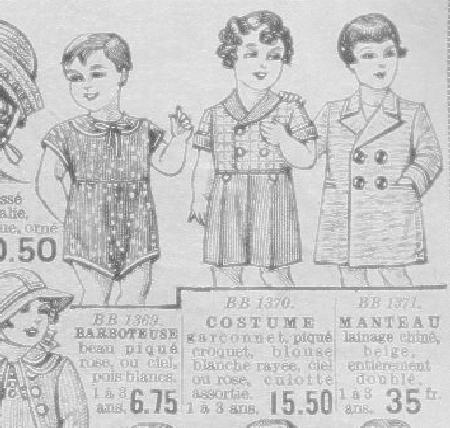
Figure 1.--This advertisement appeared in a March 1936 La Samaritaine catalog. Pictured are a boys romper, shorts set, and child's coat. Notice how the clothing for younger children even in te 1930s was by age.

French catalogs vary in how they do sizing. Some provide sizes in terms of the child's age. This was especially common for younger children. Others stores present sizes in centimeters (cm). Note that this can be confusing. Not only did stores have varying practicesm, but these practices changed over time. Another complication is that modern children are slightly taller than children in the early 20th century. Of course there is also the complication that there are substantial cariations among children in any given age group. While there are a number of variations here, French readers have provided us size/age equivalents to provide some rough indications as to the sizes of individial garments.
These lengths in early catalogs were normally for the length of the garment, NOT the heighth of the child. HBC has noted romper and smock sizing, for example, in centimeters. Rompers and smocks were sized similarly for the younger boys. Smocks for older boys werte worn longer, but at that age they no longer wore rompers. The age-size for rompers, suits and smocks couuld thus have some differences. The smock for little boys of 2-8 had the lenght at level of his pants which was often well above the knee. The smocks for older boys were worn slightly above his knee. A French reader tells us, "This rule had always been observed." The approximate age conversions would be: 40 cm (12/18 months perhaps 24 months), 45 cm (2 to 3 years), 50 cm (4 to 5 years), 55 cm (5 to 6 years), 57 cm (6 years), 60 cm (6-7 years), 65 cm (8 years), 70 cm (9 years), 75 cm (10 years), and 80 cm (11-12 years). Sizes generally before 1970s were in terms of the length of garments or the age of the children. Other size criteria need to be used for blouses, shorts, shorts, and long pants.
Boys were slightly smaller in the 1940s, presumably the result of poor nitrition during World War II and the immeduiate post-War period. Boys in 1946 averaged: 6 years old 1m03. Boys 8 years old averaged 1m14. That would mean for 6 years old 1946 a smock of 55 cm and 8 years old a smock of 65 cm.
Boys by the 1970s were noticeably taller than during the pre-War and World war II era. Boys in 1976 averaged: 6 years old 1m14 and 8 years old 1m38.
After the 1970s it was more common to give the height of the children or the age.
A French reader points out, "One must say, that the sizes were not very formal. Many mothers bought clothes a bit biger, for longer use; so the boy was able to wear items 2 years. My mother always bought clothes fot my brother and me that were the exact
size and we offten changed. It seems that we hardly ever wore out our clothes."
Navigate the Boys' Historical Clothing catalog/magazine pages:
[Return to the Main French page]
[Return to the Main country mail order page]
[Main photo/publishing page]
[Store catalogs]
[Fashion magazines]
Navigate the Boys' Historical Clothing Web Site:
[Introduction]
[Activities]
[Biographies]
[Chronology]
[Clothing styles]
[Countries]
[Topics]
[Bibliographies]
[Contributions]
[FAQs]
[French glossary]
[Satellite sites]
[Tools]
[Boys' Clothing Home]
Navigate the Boys' Historical Clothing Web Site:
[Sailor suits]
[Sailor hats]
[Buster Brown suits]
[Eton suits]
[Rompers]
[Tunics]
[Smocks]
[Pinafores]
[Postcards]
